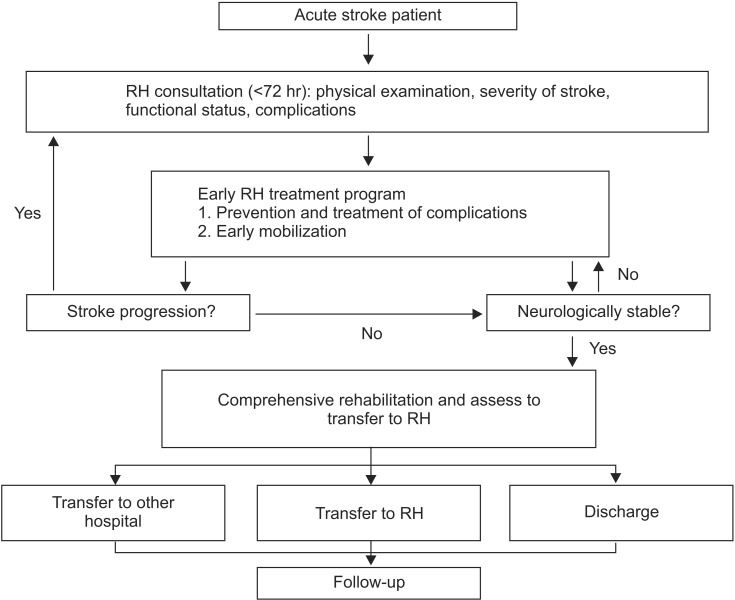Ann Rehabil Med.
2014 Oct;38(5):603-611. 10.5535/arm.2014.38.5.603.
Retrospective Assessment of the Implementation of Critical Pathway in Stroke Patients in a Single University Hospital
- Affiliations
-
- 1Department of Rehabilitation Medicine, Gyeongsang National University Hospital, Jinju, Korea. solioh21@naver.com
- 2Gyeongnam Regional Cardiocerebrovascular Disease Center, Jinju, Korea.
- 3Department of Neurology, Gyeongsang National University Hospital, Jinju, Korea.
- KMID: 2266494
- DOI: http://doi.org/10.5535/arm.2014.38.5.603
Abstract
OBJECTIVE
To evaluate the effects of the implementation of critical pathway (CP) in stroke patients treated at a single university hospital.
METHODS
A retrospective medical review collected data from 497 patients who had suffered acute stroke in the rehabilitation center. Stroke outcomes were compared between before and after the implementation of CP based on factors including demographic factors, stroke characteristics, pre-existing medical conditions, medical complications, functional states, and length of stay (LOS).
RESULTS
After the implementation of CP, the patients showed significantly higher stage for upper proximal (p=0.008) and lower extremity (p=0.001) on Brunnstrom stage and significantly lower scores for modified Rankin Scale (p=0.003) at transfer. For those with pre-existing medical conditions, there were significantly increased osteoarthritis (p=0.002) and valvular heart disease (p=0.011). Regarding medical complications during acute inpatient rehabilitation, there were significantly decreased shoulder pain (p=0.001) and dysphagia (p=0.017), and significantly increased gastrointestinal symptoms (p=0.001). Functional gain and efficiency of stroke patients during rehabilitation center hospitalization did not significantly change after implementation of CP. But, shorter LOS of total hospitalization, pre-rehabilitation center hospitalization, and rehabilitation center hospitalization were evident.
CONCLUSION
After the implementation of CP, patients less often developed complications and displayed no changes in functional gain and efficiency. They had shorter LOS of total hospitalization, pre-rehabilitation center hospitalization and rehabilitation center hospitalization.
Keyword
MeSH Terms
Figure
Reference
-
1. Park HS, Kang MJ, Huh JT. Recent epidemiological trends of stroke. J Korean Neurosurg Soc. 2008; 43:16–20. PMID: 19096539.
Article2. Dromerick A, Reding M. Medical and neurological complications during inpatient stroke rehabilitation. Stroke. 1994; 25:358–361. PMID: 8303745.
Article3. McClatchie G. Survey of the rehabilitation outcome of strokes. Med J Aust. 1980; 1:649–651. PMID: 7421621.
Article4. Roth EJ. Medical complications encountered in stroke rehabilitation. Phys Med Rehabil Clin North Am. 1991; 2:563–577.
Article5. Davenport RJ, Dennis MS, Wellwood I, Warlow CP. Complications after acute stroke. Stroke. 1996; 27:415–420. PMID: 8610305.
Article6. Espinosa-Aguilar A, Reyes-Morales H, Huerta-Posada CE, de Leon IL, Lopez-Lopez F, Mejia-Hernandez M, et al. Design and validation of a critical pathway for hospital management of patients with severe traumatic brain injury. J Trauma. 2008; 64:1327–1341. PMID: 18469658.
Article7. Kwan J. Care pathways for acute stroke care and stroke rehabilitation: from theory to evidence. J Clin Neurosci. 2007; 14:189–200. PMID: 17258128.
Article8. Cooper D, Jauch E, Flaherty ML. Critical pathways for the management of stroke and intracerebral hemorrhage: a survey of US hospitals. Crit Pathw Cardiol. 2007; 6:18–23. PMID: 17667882.9. Romito D. A critical path for CVA patients. Rehabil Nurs. 1990; 15:153–156. PMID: 2343179.10. Falconer JA, Roth EJ, Sutin JA, Strasser DC, Chang RW. The critical path method in stroke rehabilitation: lessons from an experiment in cost containment and outcome improvement. QRB Qual Rev Bull. 1993; 19:8–16. PMID: 8455920.
Article11. Patel M, Potter J, Perez I, Kalra L. The process of rehabilitation and discharge planning in stroke: a controlled comparison between stroke units. Stroke. 1998; 29:2484–2487. PMID: 9836755.12. Wolf PA, D'Agostino RB, Belanger AJ, Kannel WB. Probability of stroke: a risk profile from the Framingham Study. Stroke. 1991; 22:312–318. PMID: 2003301.
Article13. Kalra L, Yu G, Wilson K, Roots P. Medical complications during stroke rehabilitation. Stroke. 1995; 26:990–994. PMID: 7762051.
Article14. Park HK, Kang YJ, Kim HJ, Lee KS, Park KT. Influence of associated medical diseases and complications on functional improvement after rehabilitation in patients with stroke. Brain Neurorehabil. 2008; 1:190–196.
Article15. Craig LE, Bernhardt J, Langhorne P, Wu O. Early mobilization after stroke: an example of an individual patient data meta-analysis of a complex intervention. Stroke. 2010; 41:2632–2636. PMID: 20947855.16. Sorbello D, Dewey HM, Churilov L, Thrift AG, Collier JM, Donnan G, et al. Very early mobilisation and complications in the first 3 months after stroke: Further results from phase II of A very early rehabilitation trial (AVERT). Cerebrovasc Dis. 2009; 28:378–383. PMID: 19641313.
Article
- Full Text Links
- Actions
-
Cited
- CITED
-
- Close
- Share
- Similar articles
-
- Implementation of a Critical Pathway to the Dizzy Patients in the Emergency Center
- Development and Implementation of Critical Pathway for Hospitalized Herpes Zoster Patients
- A Study on Development of the Automated Critical Pathway for Patients with Cesarean Section
- Effects of Critical Pathway on the Start of Rehabilitation in Stroke Patients of Single University Hospital
- The Development of a Critical Pathway for Facial Bone Fractures and the Effect of its Clinical Implementation


